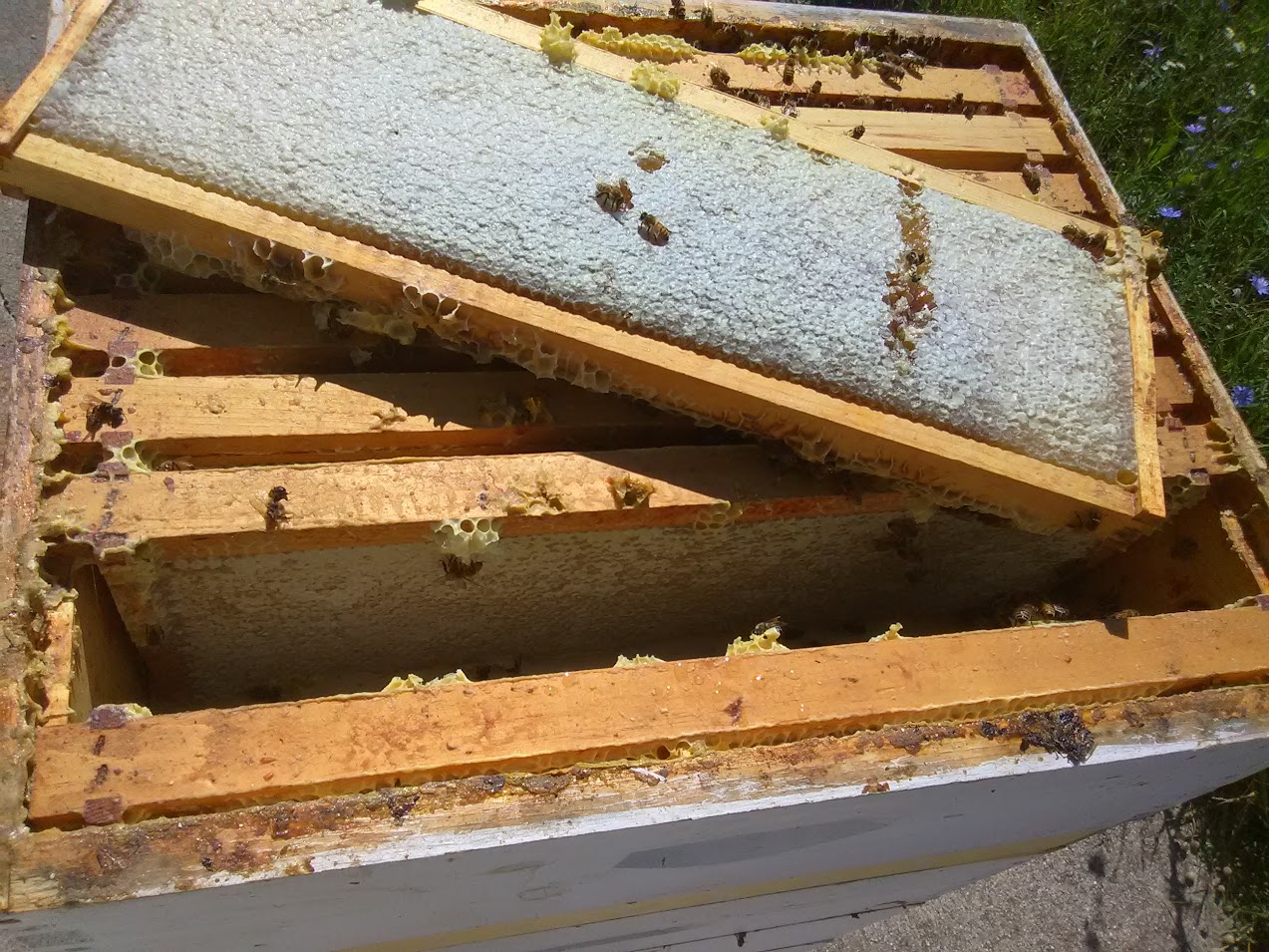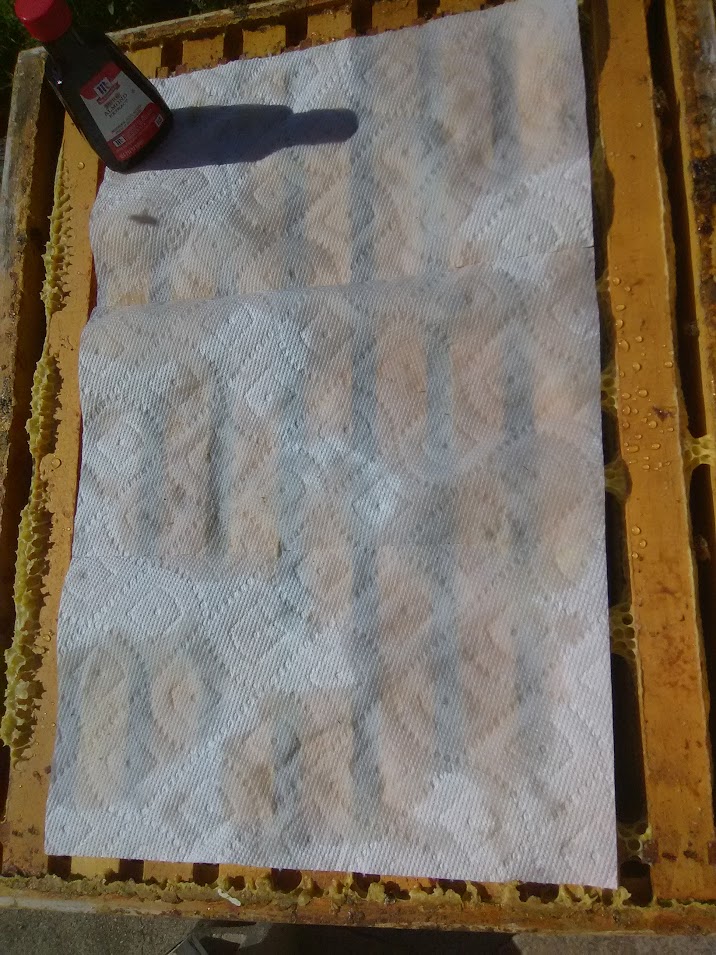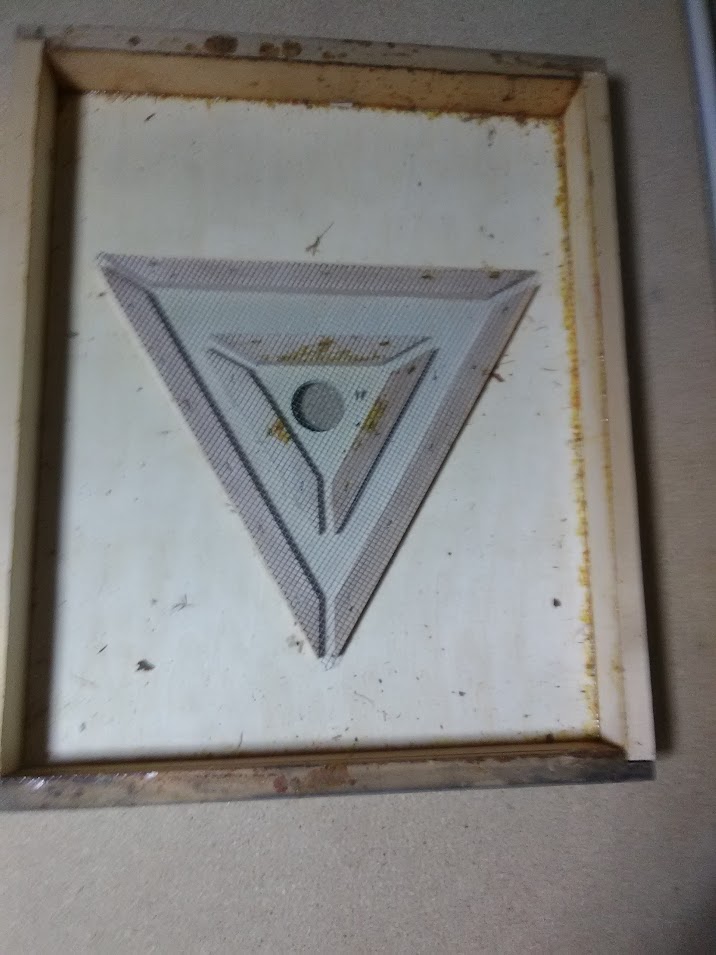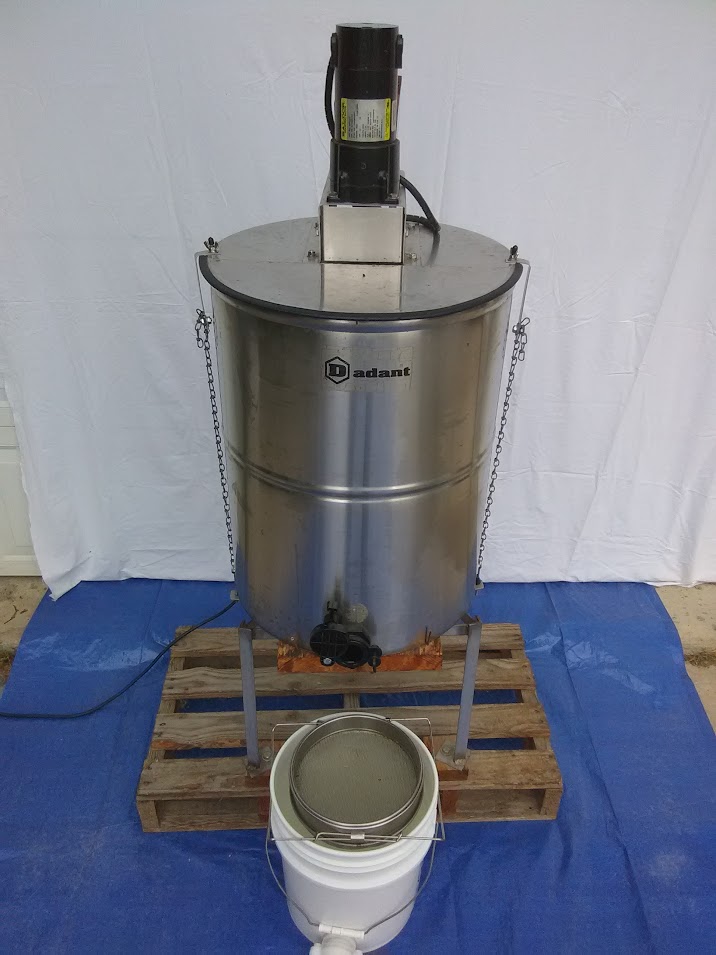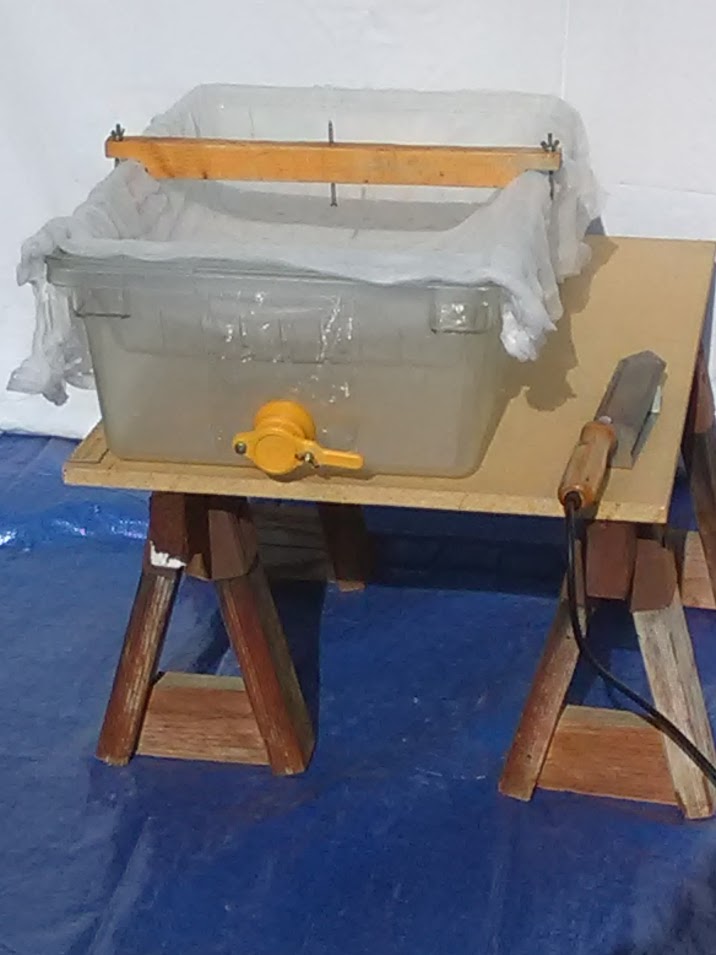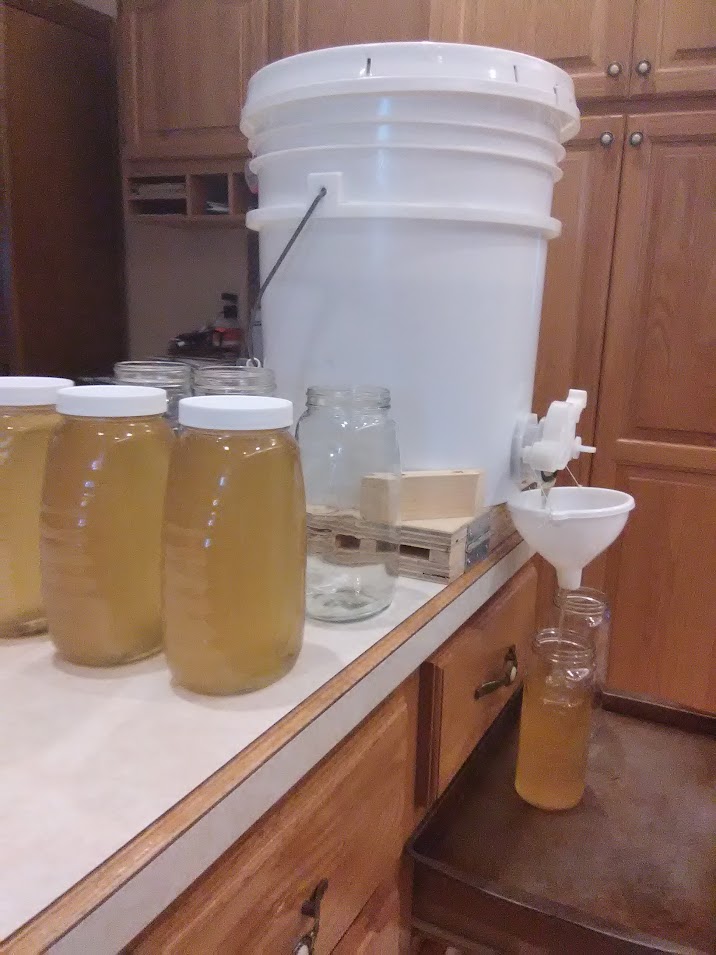Harvesting Honey
Richard Wahl
The Fruits of Their Labors:
As the Summer months turn to Fall, it might be time to consider how much honey to take from our hives. This can be just as daunting a decision and challenging a job as deciding to manage bees in the first place. The common suggestion here in SE Michigan is to leave a range of 70 to 100 pounds of honey in the hive to get the bees through our very erratic Michigan Winters. The range will vary depending on a variety of factors. Will you use insulation under the outer cover and or an insulation blanket of some type around the hive? Will you be feeding dry sugar or using a candy board through the Winter? Is your hive site protected from the chilling north and west Winter winds? Each of these factors will determine whether your hives can remain on the lighter side or should fall to the heavier side of the amount of honey to be left for the bees.
A first consideration is to have an idea as to approximately how much honey might be stored in the various sized supers. In each case that follows, I will be referring to ten frame Langstroth units. Obviously if you are working with eight frame units the weights will be lighter. This is not the honey weight itself as it includes the weight of the super box with all the frames and wax comb. A shallow ten frame super full of honey can weigh near 40 pounds if all the cells in the ten frames are filled and capped. This is especially true if the beekeeper is in a second season and is using nine drawn comb refilled frames. A medium ten frame super will weigh between 40 to 50 pounds while a deep super can weigh up to 90 pounds. It is common practice here in SE Michigan to use ten (or eight) new frames the first year. Once those frames have been neatly uncapped and extracted, the re-useable drawn comb frames can be reduced to nine in a honey super, equally spaced in the ten-frame unit, and the bees will draw them out a bit farther in their second and subsequent use. This makes uncapping a bit easier as the comb is slightly wider than the frame it sits in. It also results in a bit more honey that is stored in a nine frame super rather than a ten-frame due to the bees drawing out previously used frames a bit farther. Some beekeepers use eight frame supers that can also be reduced to seven frames in like manner, but I have only worked with nine or ten frame supers. Most bee equipment catalogues sell nine-unit frame spacers (orange) or seven unit (blue) plastic frame spacer tools to set previously drawn comb frames at equal spacing across the super. If a more refined weight measure is desired, the purchase of a suitcase scale is a convenient tool. Basic suitcase scales can be found on the internet from various sources often for under or around $10.00 in both digital and dial measurement readouts. A variety of creative ways can be found to connect the suitcase scale hook to the hive bottom. The suitcase scale hook can be attached to the super handle or to the bottom of the super and one side lifted to take a weight reading. With that weight recorded do the same on the opposite side and add the two readings together. Although not exact it will give a very close approximation of the weight of your hive or super. This is a good way to check how much honey is left in the supers for the bees food source over Winter. My normal practice is to use two deep supers and add medium honey supers above them as needed over the Summer. The honey supers are removed in late Summer to early Fall for honey extraction. Any Fall nectar flow is left for the bees to backfill the deeps for their Winter supply. Because of the added weight of ten frame deeps, some beekeepers use three medium supers for their bottom brood chambers instead of two deep supers with equal success. Also there are some who swear by the single deep overwintering method which may require more care with insulation and feeding considerations.
Queen Excluders, Yes or No:
It is up to the beekeeper as to whether or not to use queen excluders as there are pluses and minuses either way. For the first six or seven years of my beekeeping experience, I did not use queen excluders. On occasion the queen would move up into a honey super and start laying eggs which would eventually become brood and emerge. If this occurred later in the season extracting honey from frames with brood became problematic and those frames were better left with the hive. Once the queen was found in a lower deep a full honey super could be placed below the super that had some brood and as the brood emerged it was unlikely the queen would cross the full honey super and re-lay in those upper honey super frames again. The bees would normally backfill empty honey super brood cells with honey which could then go through the normal extraction process. I do not use an excluder if the honey super frames are new with no drawn comb. I have found that the bees tend to fill the brood deeps with nectar/honey a bit sooner when a queen excluder is present. Previously used drawn comb frames above the excluder seem to draw the bees up into the honey super sooner than when undrawn comb frames are used above an excluder. During several Summers when I had only two or three hives, I could add as many as five honey supers above the two deeps and expect near all to be filled if I did not do any extracting until Fall. Since those Summers, I began using queen excluders and found that it seems to slow the movement to fill honey supers. Another reason may be that rather than maintaining two or three hives, I have gone to seven to nine hives each Summer. Since there are more bees competing for the pollen and nectar in the same area, I seldom find a need to add more than three honey supers above any hive’s two deeps, although in this most recent Summer I already have two hives with three honey supers near fully capped and needing a fourth super among two of my eight hives. Any splits made from overwintered hives starting out as nucs or ten frame single deeps, before adding a second deep or the later added honey supers, will take longer for the bees to fill out.
Removing Bees and Honey Supers:
Once the frames in a honey super are over 85% filled with capped honey, the frames can be considered ready for extraction. If there are small, uncapped areas on some frames, a good shake of the frame can determine if the uncapped nectar is in near enough a honey state for extraction. If nectar drips out, it has not been cured to low enough water content and should be left for the bees. A small percentage of uncapped extracted honey when mixed with all the remaining extracted capped honey will not affect the desired 20% or below water content of the honey. Any water content too far above 18% could cause the extracted honey to ferment at a later time. If there is a concern about exact water content a refractometer found for sale in most bee catalogues can be purchased to measure the exact percent of water content. Once I find a honey super capped and ready for extraction, I like to employ a bee escape board for a day or two before removing the honey super. This requires an extra step in manipulating the honey supers, but I find it a good way to eliminate nearly all of the bees from the honey super. Although not efficient for the commercial beekeeper, it is quite amenable for the hobby beekeeper. Determine a day or two in advance of the extraction date which time the honey super(s) will be removed. Remove the inner cover and set it and the honey super aside for a moment. Place the bee escape board with the screened maze down on top of other hive honey supers or brood supers and below the honey super(s) to be extracted. I like to use a spacer below the bee escape board to provide room for the bees to exit below. This could simply be an empty frameless honey super if a shorter spacer is not available, as it will only remain on the hive for a day or two. Place the honey super(s) above the escape board. Just on top of the honey super to be extracted, I place a white paper towel over the frames with a nice sprinkling of almond extract. For some reason the bees do not like the aroma of standard baking almond extract and will exit the escape board more quickly when the almond extract is used. The paper towels do not need to be soaked; a nice sprinkling of the almond extract across most area of towel is sufficient. Of course, one could purchase the more expensive fume board and a liquid bee chaser sold in any of the beekeeping catalogues. Place the outer cover directly over the paper towel on the top honey super. Leave the inner cover off for the day or two while the escape board is on. There should be no top entrance for the bees to get back into the honey super once they exit through the escape board below. For a single honey super, most bees will have exited within a day. If set below two supers, it will take several days for most bees to exit the honey supers. I have not used an escape board below more than two honey supers at a time. If left below a single honey super for two days, I rarely find more than three or four bees remaining in the honey super come time for removal. If by chance there is any brood in the honey super, the bees will not leave the brood, regardless the liquid chaser used. When ready to remove the honey super, have two outer covers nearby. Quickly set the honey super into an upside down outer cover and place another outer cover over the honey super to keep other curious bees out of your near empty of bees honey super. With multiple escape boards, more honey supers from several hives can quickly be added to the stack, always covering the top one with the second inverted outer cover. I set the covers and honey supers on a two wheeled hand cart that can easily be moved to my extraction site. If one moves quickly, any remaining bees can be brushed off frames once supers are removed from the immediate hive area.
Honey Extraction:
I have a variable motorized extractor mounted on a 4 x 4 wooden pallet. The extractor can hold six medium frames or three deep frames. I normally move my extractor into a warm greenhouse which keeps the honey flow going even on cool Fall days. I have also extracted in my garage. In both cases, I throw a tarp over the extraction area floor to be able to catch any honey drips or overflows making after extraction cleanup easier. To help stabilize the extractor, I place two cement blocks for additional weight on the pallet. I have to admit that on occasion I have not tightly closed the extraction tray faucet or honey catching bucket faucet tightly, and have had leaks onto the tarp. There has also been an occasion where the screens sitting on the bucket became clogged with wax or the honey flow from the extractor was too fast and honey flowed over the screen lip edges when not watched carefully. I always have a second five-gallon bucket on hand as it is hard to judge just how much each honey super will produce. Once the honey has flowed out of the extractor, through the double screen and into the five gallon bucket, when nearly full, it goes to my kitchen counter for bottling. A multi drawer kitchen cabinet with the second drawer pulled out holds a cookie sheet that bottles can be set on at just the right height to be filled from the bucket. In addition to the bucket of honey, to collect even more, I line the inner tank of my uncapping tub with grade 60 cheesecloth. When left to sit in the closed covered uncapping tray overnight, additional honey drains through the cheesecloth and into the bottom of the uncapping tray. The double layer of grade 60 cheesecloth works just as well as the bucket screens. The additional honey in the extracting tub can be added to the five-gallon buckets for later bottling.
Bottling and Selling:
This is the fun part. Seeing dozens of pounds of honey sitting in containers on the kitchen counter, glimmering in the sun and ready to be labeled is an enjoyable sight. I can usually make a good estimate as to how much honey I will be able to bottle based on the number of hives I have and how strong they are in late Spring. Based on those estimates, I order containers as early in the season as possible since some companies will run out of bottling containers as the late Summer/early Fall honey extraction process intensifies in our area. Any extra containers can always be used in the next season. I have designed my own color labels, which I print out on standard postal address label sheets, and then peel and attach to the various jars that I use. I have always included the Michigan Department of Agriculture label requirement which allows me to legally sell my honey in retail stores under their cottage industry rules. Check your own state or country department of agriculture cottage industry rules to meet retail labeling requirements in your jurisdiction area. I have only used the retail market once when COVID-19 shut all intra-personal activities down; no craft shows, church bazaars or farm markets where I could sell my honey. I adjust my price per pound annually based on the current market demand, send out a price flyer to regular customers and am usually sold out by our Thanksgiving or Christmas holidays simply by word of mouth endorsements. Overall, it has been a fun adventure. Your experience may vary based on your local market demand, environmental conditions, experience or state of your hives. Enjoy the adventure and you will find it does not take long to start covering the cost of your time, investment and equipment.







